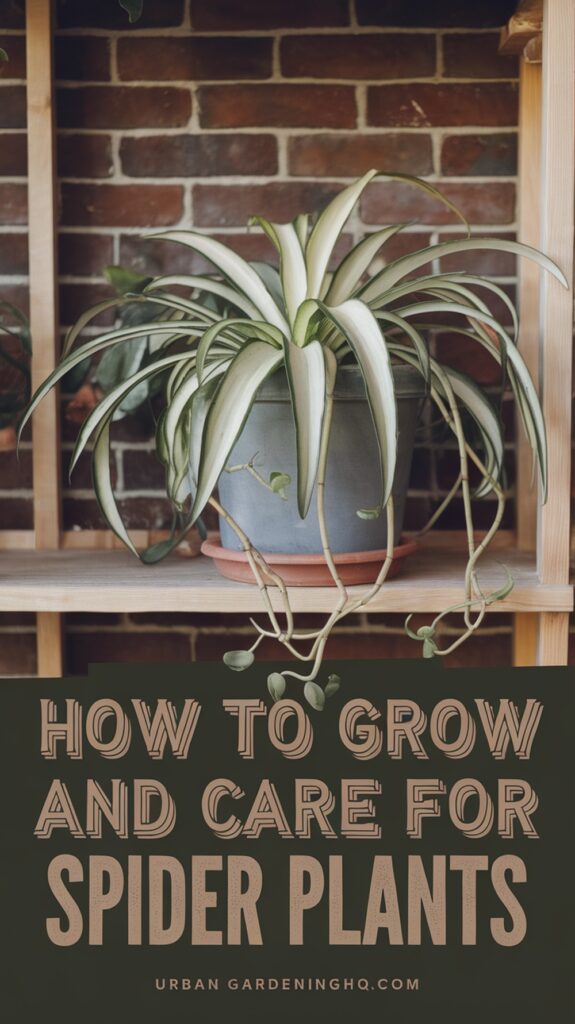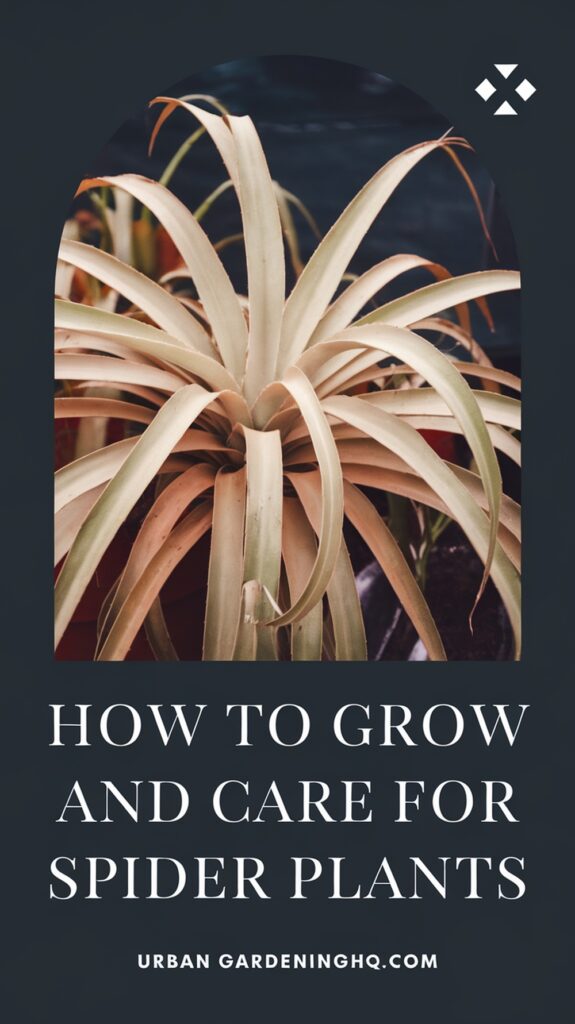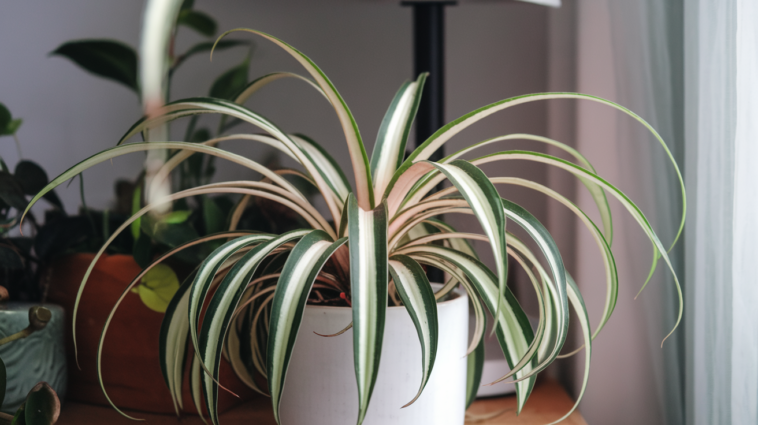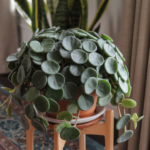I’m excited to share the joys of growing spider plants. They are popular for being easy to care for and purifying the air. Spider plants are great for busy people who want greenery without hassle.
Spider plants are not just beautiful; they also purify the air and reduce stress. This makes them perfect for any indoor space. In this article, I’ll share tips on growing thriving spider plants. I’m excited to help you find the right plants for your lifestyle.
Meet the Versatile Spider Plant: Nature’s Easy-Care Wonder

Spider plants are fascinating, with unique traits and adaptability. They come from South Africa and love well-draining soil and partial shade. This makes them perfect for indoor spaces. With varieties like ‘Variegatum’ and ‘Tricolor’, it’s easy to see why they’re popular.
Spider plants are great for indoor spaces. They purify the air, reduce stress, and add beauty. They’re perfect for both experienced gardeners and beginners.
Origins and Natural Habitat
Spider plants are from South Africa’s tropical areas. They thrive in well-draining soil and partial shade. This environment helped them adapt well to indoor spaces.
Popular Spider Plant Varieties
Some favorite spider plant varieties are:
- ‘Variegatum’: known for its striking white and green leaves
- ‘Tricolor’: features leaves with a mix of white, green, and yellow colors
- ‘Curly’: has curly, twisted leaves that add a unique touch to any space
Benefits of Growing Spider Plants
Spider plants have many benefits. They purify the air, reduce stress, and are beautiful. They’re also easy to care for. They’re a great choice for adding green to your home or a low-maintenance plant.
Essential Light Requirements for Spider Plant Success
Exploring indoor plants, I learned light needs are key. Spider plants love bright, indirect light. They’re perfect for rooms with little natural light. But, direct sunlight can burn their leaves, so they need shade, mainly when the sun is strongest.
For the best growth, put your spider plant by an east- or west-facing window. This way, it gets plenty of indirect light. For more tips on caring for spider plants, check out joyusgarden.com. Important light tips include:
- Avoid direct sunlight, mainly during peak hours
- Give them some shade to avoid leaf burn
- East- or west-facing windows are best for them
Knowing your spider plant’s light needs helps it thrive. Spider plants are excellent for indoor spaces. With the right light, they’ll grow well and add beauty to your home.
Water and Humidity: Finding the Perfect Balance

To keep my spider plant thriving, finding the right balance between water and humidity is key. A good watering schedule prevents overwatering and underwatering. Overwatering can cause root rot, while underwatering leads to leaf drop. I watch how the plant reacts to its environment to adjust the watering schedule for its best growth.
Managing humidity is also vital for a healthy spider plant. I aim for a humidity level of 50-60% to stop pests and encourage growth. I use a humidifier or a water tray with pebbles to keep the humidity right. This method also helps avoid pest control problems, keeping my plant healthy without pesticides.
Key Considerations for Watering and Humidity
- Establish a watering schedule to prevent overwatering and underwatering
- Maintain a humid environment, around 50-60% relative humidity, to promote healthy growth
- Monitor the plant’s response to its environment and adjust the watering schedule as needed
- Use humidity management methods, such as a humidifier or water tray, to prevent pest control issues
By following these guidelines, I create the perfect environment for my spider plant. This helps prevent pests and allows me to enjoy a healthy, lush plant.
Soil and Fertilization Guidelines
To make sure your spider plant does well, knowing about soil and fertilization is key. Spider plants like soil that drains well and is full of organic matter. This helps them grow strong and healthy. A balanced fertilizer is also important for their growth.
For fertilizing, a balanced, water-soluble fertilizer is best during the growing season. It gives your spider plant the nutrients it needs without harming it. Too much fertilizer can hurt your plant, so finding the right amount is important. Also, repotting your spider plant every 2-3 years helps keep the soil fresh and right for your plant.
Here are some key tips to keep in mind:
- Use a well-draining potting mix to prevent waterlogged soil
- Apply a balanced, water-soluble fertilizer during the growing season
- Repot your spider plant every 2-3 years to refresh the soil
- Avoid overfertilizing, as this can cause more harm than good
By following these guidelines, you can give your spider plant the best soil and fertilization. This helps it grow well and stay healthy. Always put your plant’s health first and adjust your care as needed.
How to Propagate Your Spider Plant
Exploring spider plants is exciting, and I’m here to share how to propagate them. Propagation is a fun way to share your plants with others. It’s surprisingly easy. Spiderettes, the baby plants on long stems, are a popular choice.
To start, just cut off a spiderette. Then, pot it in soil that drains well. Keep it moist until it grows strong. This method is simple and effective. You can also divide the roots of the mother plant to create new ones. Leaf cuttings work too, but they need more care.
If you’re new to plant propagation, learning the basics is key. Check out urban gardening resources for more info. Here are some important tips for propagating spider plants:
- Use well-draining soil to prevent waterlogged soil
- Keep the soil moist but not waterlogged
- Provide indirect sunlight for the new plants
By following these tips and using the right methods, you can grow new spider plants. Enjoy the many benefits these plants offer.
Solving Common Spider Plant Problems
As a spider plant lover, I’ve faced many issues like pests, leaf drop, and root rot. Spotting these problems early is key. For pests like spider mites or mealybugs, insecticidal soap or neem oil works well. Regular pest control helps prevent infestations too.
Leaf drop or root rot can be fixed by adjusting watering and improving air flow. Knowing about diseases like leaf spot or tip burn is important. Taking steps to prevent these can keep your spider plant healthy.
Here are some ways to prevent common problems:
- Watch your watering to avoid overwatering and root rot
- Ensure your plant gets enough light and nutrients
- Keep your plant clean and check it often for pests or diseases
By following these tips, you can enjoy your spider plant’s benefits. They purify the air and look great. Remember, preventing problems is essential for a healthy spider plant. With the right care, you can enjoy these plants for many years.
Creating the Perfect Container Environment

To make sure your spider plant does well, you need to pick the right container. Look for a pot that drains well and is a bit bigger than the plant’s roots. This size helps the roots grow and keeps the soil from getting too wet, which can harm the plant.
A pot that drains well is key for a healthy home for your plant. You can find pots with holes or add rocks or broken pottery at the bottom. Also, repotting is important. It lets you change the soil and trim the roots. I suggest repotting every 2-3 years with a bigger pot and fresh, draining soil.
Here are some important tips for choosing a pot and repotting:
- Choose a pot that is 1-2 sizes larger than the current one to provide enough room for growth.
- Select a potting mix that is designed for tropical plants like spider plants.
- Repot your spider plant in the spring or summer when it’s actively growing.
By following these tips, you can make a great home for your spider plant. This will help it grow well and avoid problems. Remember, the right container is a big part of taking care of your spider plant.
Advanced Tips for Lush Spider Plant Growth
To make your spider plant thrive, you need to give it special care. This means changing how you care for it with the seasons. This way, your plant gets the right water and food when it’s growing, and less when it’s not.
Pruning is also key for a healthy spider plant. It keeps the plant looking good and stops pests. To prune, cut off dead or damaged parts and trim long branches. This keeps your plant in top shape.
Seasonal Care Adjustments
Here’s how to adjust your care with the seasons:
- Water and feed more during the growing season to help it grow.
- Water and feed less in the dormant season to avoid root rot.
- Watch how your plant reacts to the seasons and adjust your care as needed.
Pruning for Perfect Shape
Pruning is vital for your spider plant’s health. You can prune it any time of the year. Here’s how:
- Use clean, sharp tools to avoid spreading diseases.
- Take off dead or damaged leaves and stems to stop disease spread.
- Trim long branches to keep the plant’s shape and encourage growth.
Conclusion: Your Journey to Spider Plant Mastery
As you finish your spider plant care journey, you now know how to grow healthy plants. Remember, keeping a routine is important. Give your plants the right light, water, and food to help them grow well. Also, don’t forget to divide and repot your plants to keep them strong and vibrant.
This guide has given you the tools to become a spider plant expert. These plants are great for cleaning the air and adding a peaceful touch to any room. By following the care tips in this guide, you’ll have beautiful, thriving spider plants to enjoy for many years.


